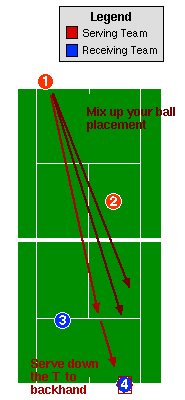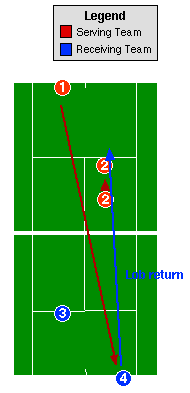<% ns_puts [nsv_get mkm_includes mkm_oldContentHeader_inc] %>
Strategy Lesson
of the Week
Handling the Lob Return in Doubles
By Monty Basynat, TennisONE Editor
If you're facing opponents who are constantly mixing up their returns with
deep chip lobs as well as penetrating low returns, then your opponents are:
1) probably beating you; 2) not respecting your team's ability to serve
while they are beating you. Let's put an end to both.
A smart doubles team understands that serving is the one stroke that lets
your team start out the point on the offensive. The first and best
way to handle a team that lobs off your return is make some adjustments
in your serving game to maintain your offensive posture.
 Smart Ball Placement with Spin First
Serves
Smart Ball Placement with Spin First
Serves
The smart doubles team knows the tactical and psychological advantage
of the serving team lessens--if not totally shifts to your opponents--if
the serving team is always serving second serves. So the solution is common
sense: serve more first serves. But how can you do that without increasing
the number of first service errors--which will again result in more second
serves and a forfeiture of the offensive advantage you're desperately trying
to keep? The adjustment your team needs to make is to hit more high
percentage spin first serves into the three areas shown on the graph.
Serving down the "T"
Everything being equal (your opponent has an equally good forehand and backhand),
the service down the middle or "T" is usually the best serving
tactic among the three serves shown. The returner must hit crosscourt
and avoid the net man. Or, he must hit down the line, hitting past the net
man and over the high part of the net, both of which make this a lower percentage
play.
However, few things in tennis are equal, including your opponent's forehand
and backhand. Most club players have a stronger forehand than backhand.
So when you're serving to the deuce court against a right handed player
(don't lamely tell your partner after the match, "I forgot who was
right handed and left handed"), the serve down the "T" is
generally the best play. When you're serving to the add court, you may need
to rethink your ball placement. If your opponent is right handed and has
a much better forehand than backhand, then the serve down the middle to
his forehand doesn't make much sense, except to mix it up. The ball placed
out wide to your opponent's backhand may be the shot you go back to most
frequently.
When serving, you should think of yourself as a baseball pitcher mixing
up your pitches. Along with varying the pace of your serve, you
should vary the placement of the serve. This keeps the returner guessing
and will ultimately make it more difficult to effectively lob your return.
 Adjust Your Net Positioning
Adjust Your Net Positioning
Unfortunately, on rare occasions you will run into a team that successfully
lob returns no matter how well you serve. This is when your net partner
(Player #2) should adjust his positioning. Instead of standing in the normal
position (somewhere near the middle of the service box), Player #2 should
take a step or two back. Just when he adjusts his position back and
how far he moves back depends on 1) how well Player #1 is serving; 2) how
well Player #2 can retreat and hit an overhead. If
Player #1 is serving poorly or Player #2 can't move well or doesn't have
much confidence in his overhead, he should set up deep enough to be able
to handle most of the lob returns hit his way. But a good way to surprise
your opponents and get a few easy points is for Player #2 to move back after
the serve. Then your lobbing opponent plays his favorite lob return and
kaboom , Player #2 is waiting to smash an overhead winner. Another reason
for Player #2 not to setup up deep in advance is that this may give the
returning opponent too much confidence and room to chip a return at Player
#2's feet. So just as you mix up your serves, mix up where you setup
at the net.
Send in Your Strategy Questions to TennisONE
If you think you have a good TennisONE Strategy Question, please send an
email to: question@tennisone.com.
<% ns_puts [nsv_get mkm_includes mkm_oldContentFooter_inc] %>
 Smart Ball Placement with Spin First
Serves
Smart Ball Placement with Spin First
Serves Adjust Your Net Positioning
Adjust Your Net Positioning